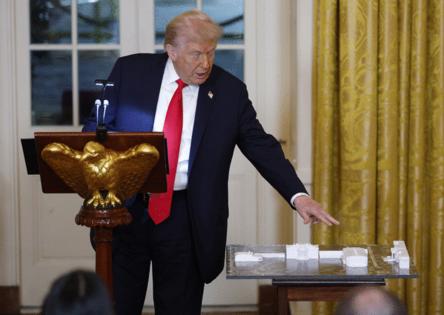Taxpayers will pay plenty over the years for Trump's massive ballroom, experts say
Published in News & Features
WASHINGTON — President Donald Trump’s plan to erect a massive ballroom where the White House’s historic East Wing once stood has reignited old questions about the power of the purse and new ones about an unchecked executive branch.
Trump asserts that the $300 million project for a 90,000-square-foot structure with “glass walls” will be “entirely privately funded.” Still, some experts warn the contentious project could end up costing taxpayers serious money over the years. While the president has talked of lavish state dinners and other celebrations inside the ballroom — and even a future presidential inauguration — much remains unknown about the coming building.
That includes all of the financing details, especially how much it will take to operate and maintain the sprawling structure — slated to mirror the size of an on-campus college basketball arena for a mid-major team. The nearby Charles E. Smith Center on the campus of George Washington University is around 100,000 square feet following a 2009 renovation, according to Baumann Consulting, which was heavily involved in that project.
Those in Trump’s orbit insist the ballroom will be financed solely through “private donations,” but the president has not resolved questions about whether his team has made any efforts to comply with federal laws and ethics rules. Those unanswered questions have set off alarms among government analysts, who, besides fretting about future operating costs, have warned that the overlap between Trump’s businesses, political impulses and personal ventures remain as tangled as ever.
Edward Lengel, a former chief historian for the White House Historical Association, said Monday that when it comes to the private-only funding vows, “they can’t live up to that promise over the long term.”
“What’s been obvious from the beginning is the whole idea that this is a gift to the American people is really a misdirection,” he said. “The reason it’s being privately funded is so Congress couldn’t block the president from doing this.”
“The cost is going to overrun significantly. The ballroom likely is going to be larger and more ostentatious than we’re being led to believe,” Lengel added. “There are almost certainly going to be approaches to Congress for funding after this is done. But the current administration clearly believes that won’t occur on their watch. That it’ll be up to the next president — Republican or Democrat.”
What’s more, attorney Bruce Fein, who specializes in constitutional and administrative law, said in a Saturday email that “private money to build a White House ballroom flagrantly violates the Anti-Deficiency Act, which safeguards the congressional power of the purse by prohibiting the president from using non-appropriated funds donated by private parties for a government purpose indistinguishable from plutocracy.”
“Without enforcement of the Anti-Deficiency Act, the congressional power of the purse is a scarecrow in the ‘golden age’ of billionaires eager to curry favor with the government in exchange for multimillion-dollar regulatory or tax favors,” Fein added.
Several previous presidents have made major renovations to the executive complex, but those came when the building drastically needed repairs and with congressional approvals. Trump did not seek lawmakers’ approval to raze the East Wing nor has he submitted plans or a request to build the large ballroom.
There are no monies in annual appropriations for White House repairs, alterations and other improvements, save $2.5 million for the “executive residence,” which rises between the outer wings. There is another $15 million for the “operating expenses” of the executive residence.
Crews last week used heavy machines to dismantle the former East Wing, sending echoes of loud banging through Lafayette Park and across H Street. Some saw a political metaphor as pieces of history crashed to the ground, leaving a smoky haze a few hundred yards behind the White House’s famed North Portico.
“This is a president who has gone from admitting that he did not know what he was doing at the beginning of his first term to understanding he can just do whatever the hell he wants in his second term,” said one longtime White House observer, who has seen multiple renovations up close, granted anonymity to be candid. “And that he doesn’t have to do other things.”
‘Modern and beautiful’
To that end, Republican lawmakers have shown no signs of breaking with Trump on the ballroom or many of his other unprecedented second-term actions.
“It’s going to be a permanent renovation that will enhance the White House for all future presidents,” House Majority Leader Steve Scalise, R-La., said of the ballroom project last week. “What (does) every Democrat say? They say no to that. They say no to everything he does because they just are angry about the results of the election from last year.”
Trump and his aides have repeatedly told reporters that not one penny of taxpayer money will be used for the project. A White House official late last week shared a list of donors that included Amazon, Apple, Caterpillar, Comcast, Google, Lockheed Martin, Meta, Microsoft, T-Mobile, Union Pacific Railroad and other large companies and wealthy individuals.
That donor list has sparked outrage from Democrats and left-leaning government watchdog groups.
“Trump is demonstrating his corruption with demolition. Money buys access and influence and in this case a long-term presence on the White House wall. This is easily understood and blatantly disgusting,” Lisa Gilbert, co-president of Public Citizen, said in an Oct. 23 statement.
Despite the influx of private cash, history suggests public funds inevitably will come into play once government-operated and -maintained security, communications, logistical and other systems unique to the presidency enter the planning.
White House press secretary Karoline Leavitt told reporters Thursday that some White House offices that had long been located inside the former East Wing would eventually be housed inside the ballroom.
“The plans changed when the president heard counsel from the architects and the construction companies, who said that in order for this East Wing to be modern and beautiful for many, many years to come, for it to be a truly strong and stable structure, this Phase 1 that we’re now in was necessary,” she said. “It’s going to be, again, like I said, much more stable, strong, secure and more beautiful than ever once it’s complete.”
Asked about the future locations of traditional East Wing mainstays such as the offices of the first lady and White House social secretary, Leavitt replied: “In the East Wing.”
‘It’s just gone’
Notably, those offices receive annual appropriations from Congress.
“Whether he uses the $230 million he’s suing the Justice Department for, or he dips into first lady or social secretary appropriations, that’s all taxpayer money,” said the longtime White House observer. “So that’s the people’s money, however it comes to him.”
The same observer said the total cost of the ballroom and office space structure could still grow — “unless the staff can talk him into reducing the size of the thing, which would bring the cost down and make the need for taxpayer dollars less.”
“We just don’t know very much about the plans or how the space would function for these big events that the president talks about. We don’t know the actual dimensions. We don’t know where the offices would physically be. We don’t know where the kitchen will be — and that will dictate a lot about the space. And we don’t know if they’re going to build underground, which would increase the final cost,” the observer added. “But we do know one thing: The history of the old East Wing is lost. It’s just gone.”
In an Oct. 21 letter to administration officials involved in the project, Carol Quillen, the president of the National Trust for Historic Preservation, said her organization “acknowledges the utility of a larger meeting space at the White House.”
But Quillen said her group was “deeply concerned that the massing and height of the proposed new construction will overwhelm the White House itself — it is 55,000 square feet — and may also permanently disrupt the carefully balanced classical design of the White House with its two smaller, and lower, East and West Wings.”
“The federally recognized Secretary of the Interior’s Standards for Rehabilitation offer clear guidance for construction projects affecting historic properties,” she added. “The standards provide that new additions should not destroy the historic fabric of the property and that the new work should be compatible with existing massing, size, scale, and architectural features.”
Once the space is erected and fully operational, its upkeep and staffing would become a part of the executive branch’s annual congressional appropriations. That means, one way or another, taxpayers’ money will eventually end up flowing into Trump’s ballroom. So even if the costs to install things such as marble and chandeliers are covered by Trump and his corporate donors, the longer-term security and communications systems would be federally maintained.
Trump’s campaigns and second-term operation have made great use of gray areas and loopholes in federal and constitutional law. The ballroom project appears to follow that same pattern — technically defensible on paper, but ethically dubious in practice.
But one problem for his detractors likely will be enforcement. None of his critics, including Democratic lawmakers, were able to do a thing to stop the razing of the East Wing. Even if watchdogs or journalists were to expose a questionable funding arrangement for the ballroom, the odds of formal consequences or stopping the project remain slim.
“The only thing that prevented this in the past was previous presidents followed norms and traditions. But Trump figured out that they weren’t legally required to do so,” Lengel said. “Typically, this administration has shown, on a zillion different fronts, they plan something out in private and then they go with a Pearl Harbor strategy — they launch the surprise attack. And before anyone realizes what’s really going on, the damage is done.”
_____
©2025 CQ-Roll Call, Inc., All Rights Reserved. Visit cqrollcall.com. Distributed by Tribune Content Agency, LLC.







Comments